Abstract
Methods have been developed for the detection of exposure to carcinogens and other DNA damaging agents in experimental animals and man through the detection of carcinogens or their metabolic derivatives in body fluids, or through adducts bound covalently to DNA or hemoglobin. The successful use of urinary markers of genotoxic exposures has been reported with respect to nitrosoproline as an indicator of exposure to N-nitroso compounds. The same approach has been used to detect AFB1 and AFB1-N7-Gua as markers of exposure to aflatoxin B1; of 3-methyladenine produced as a result of exposure to methylating agents; and thymine glycol as an indicator of exposure to agents causing oxidative damage to DNA. Detection of adducts formed between genotoxic agents and hemoglobin has been reported in studies of populations occupationally exposed to ethylene oxide, in which 3-hydroxyhistidine and 3-hydroxyvaline have been measured, and in smokers, whose hemoglobin has been found to contain levels of 4-aminobiphenyl and 3-hydroxyvaline that were correlated with the frequency of cigarette smoking. Detection of DNA adducts of genotoxic agents in the cells and tissues of exposed individuals has also been accomplished through the use of several types of analytical methods. Immunoassays and physicochemical methods have been applied to detect adducts formed through the major intermediate in the activation of benzo(a)pyrene, the 7,8-diol-9,10-epoxide (BPDE). This adduct has been found in the DNA of peripheral leukocytes of workers in foundries, aluminum manufacturing plants, roofers, and coke oven plants, and also in cigarette smokers.(ABSTRACT TRUNCATED AT 250 WORDS)
Full text
PDF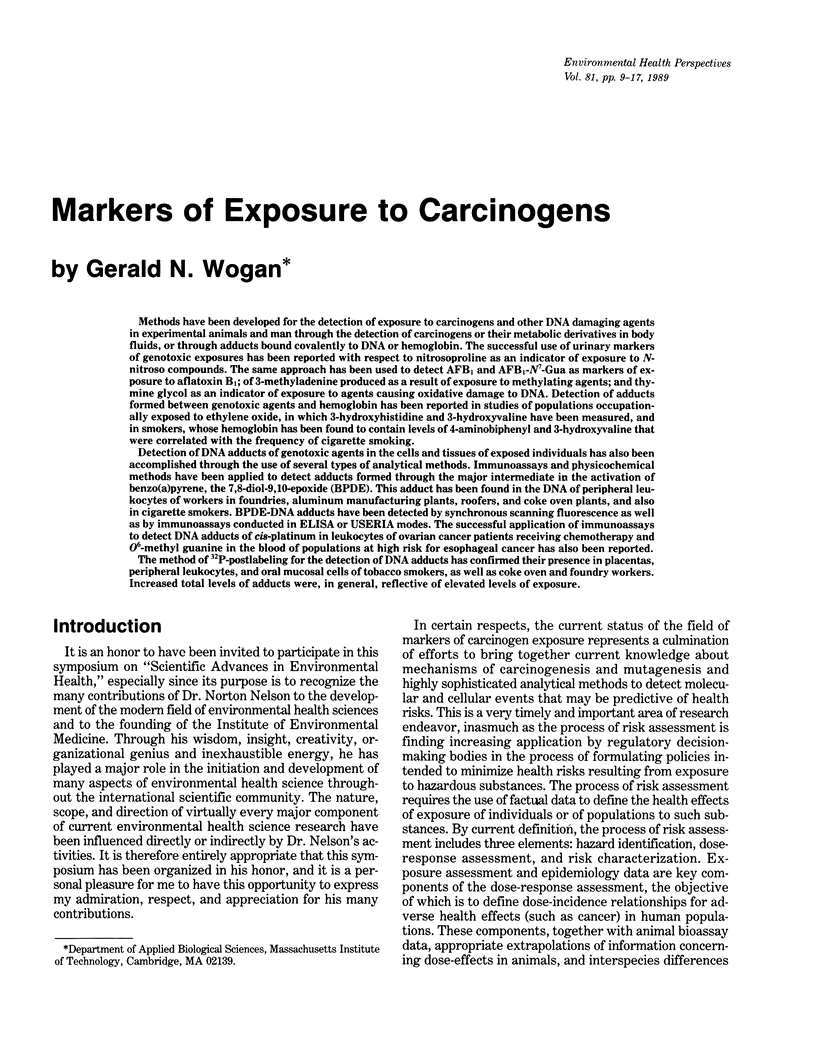
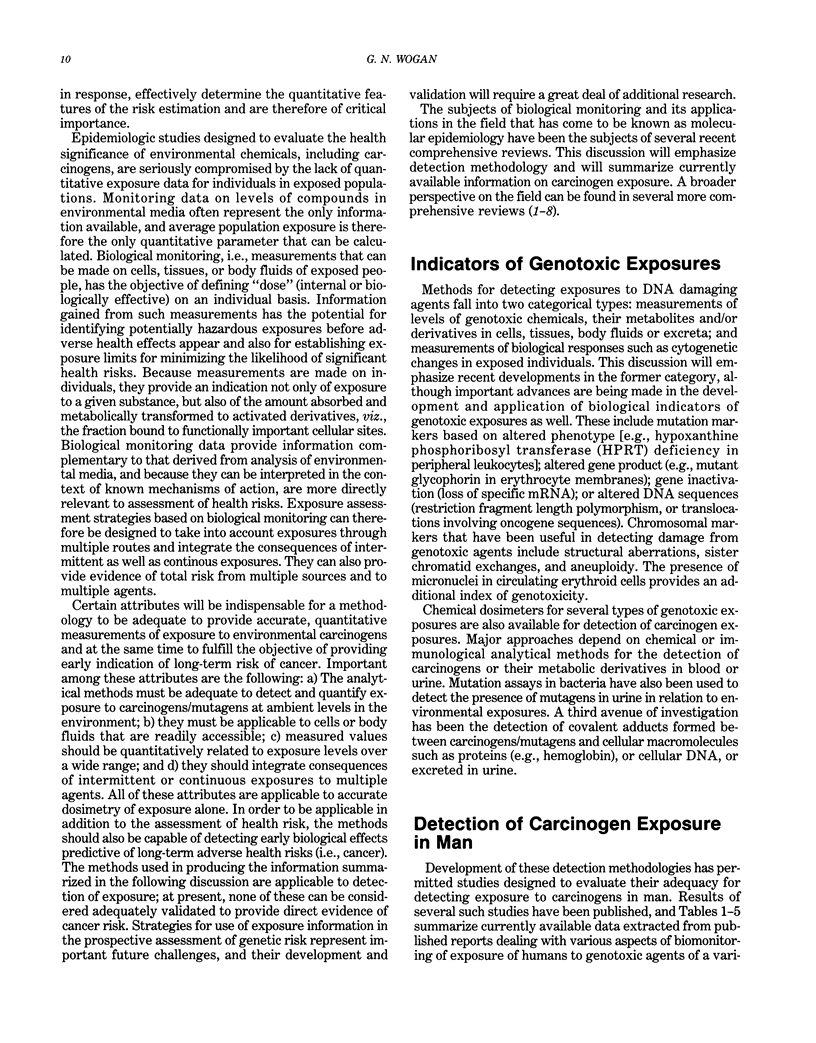
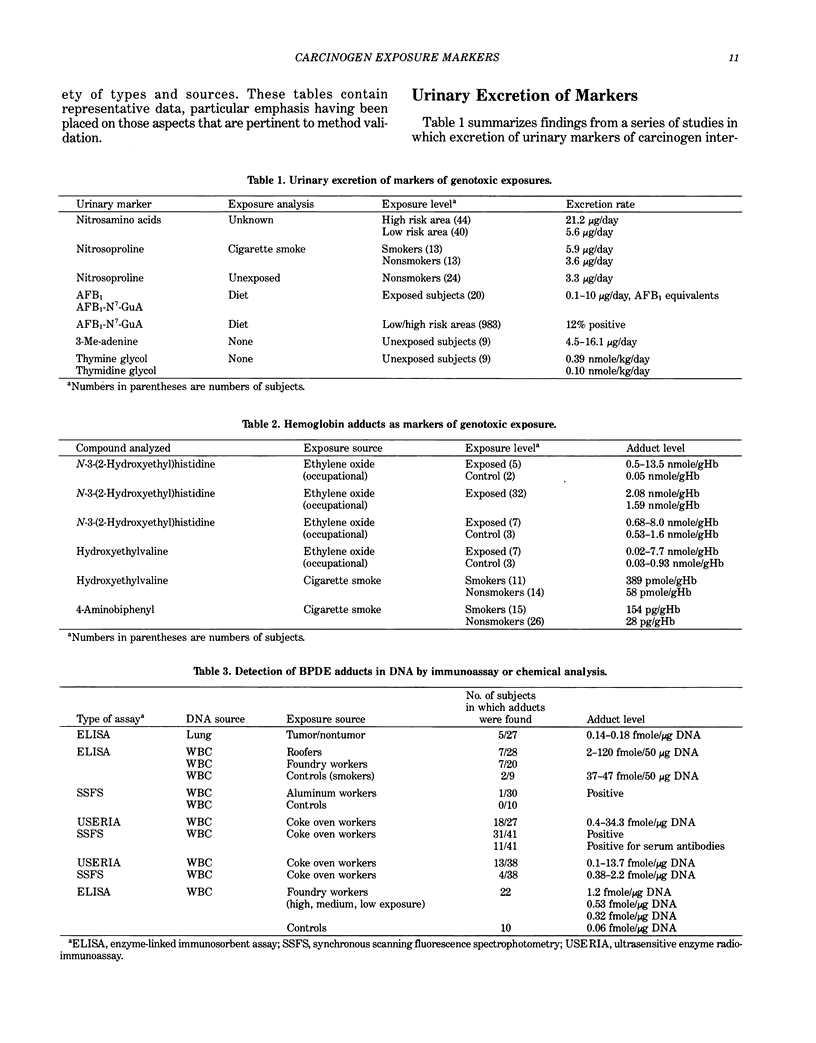
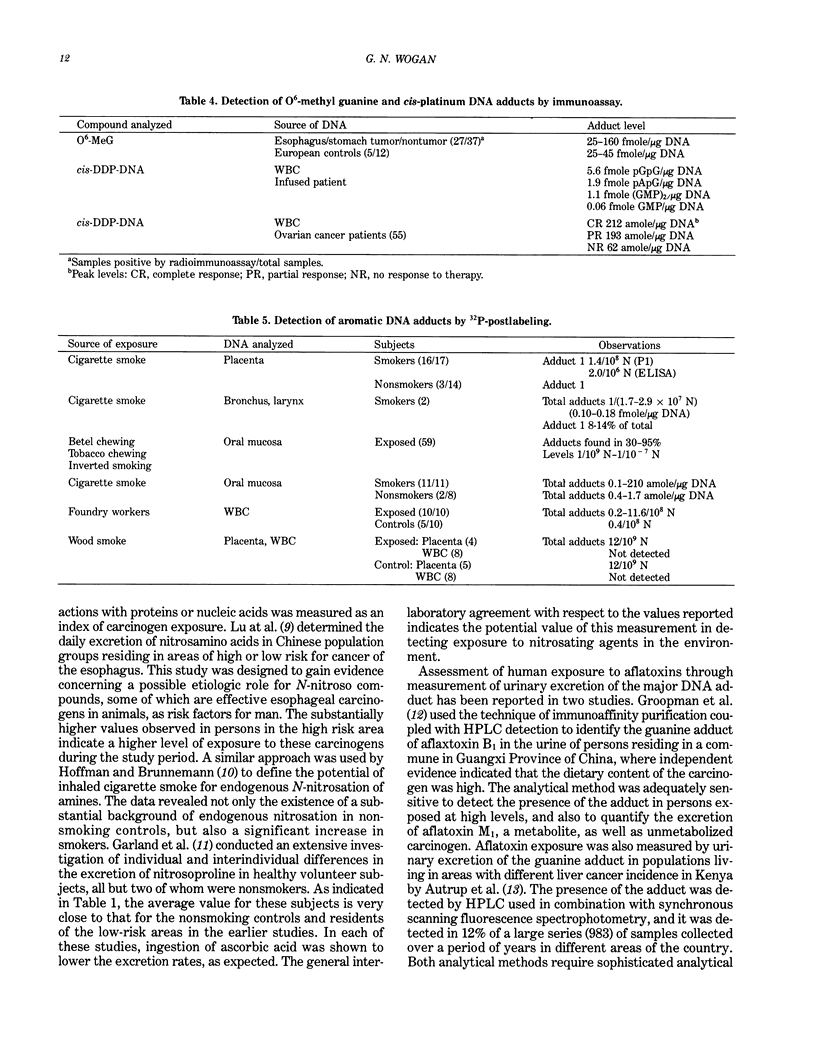
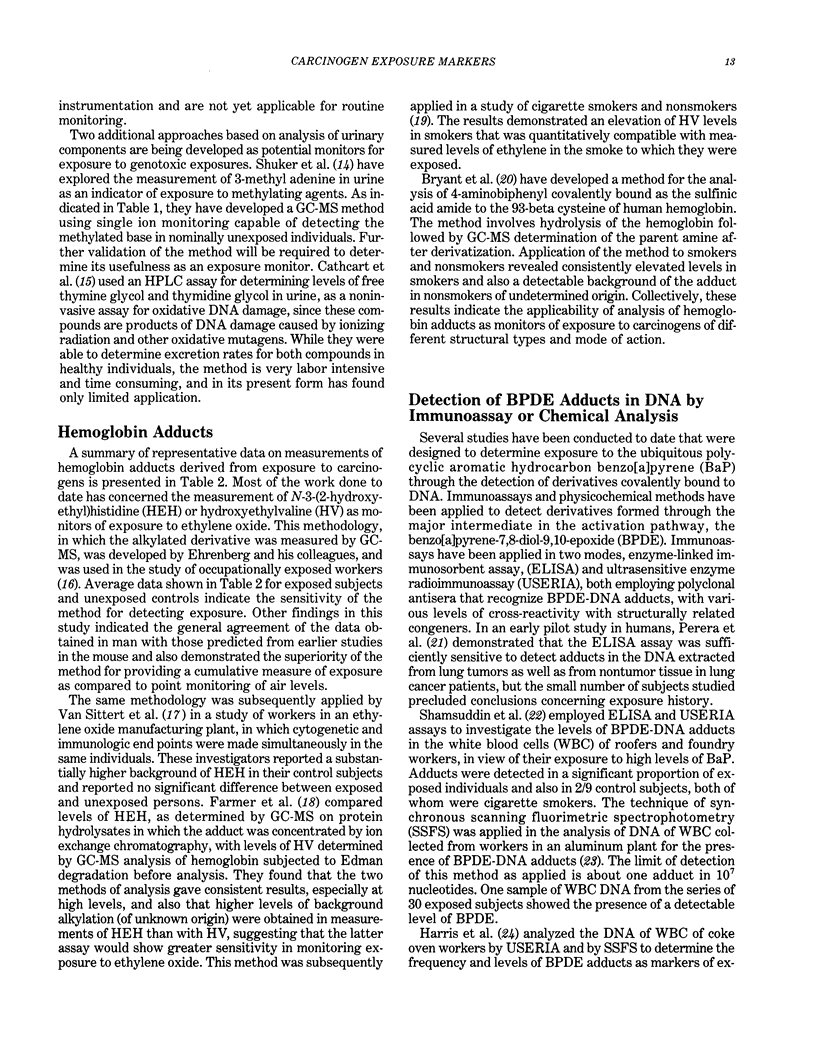
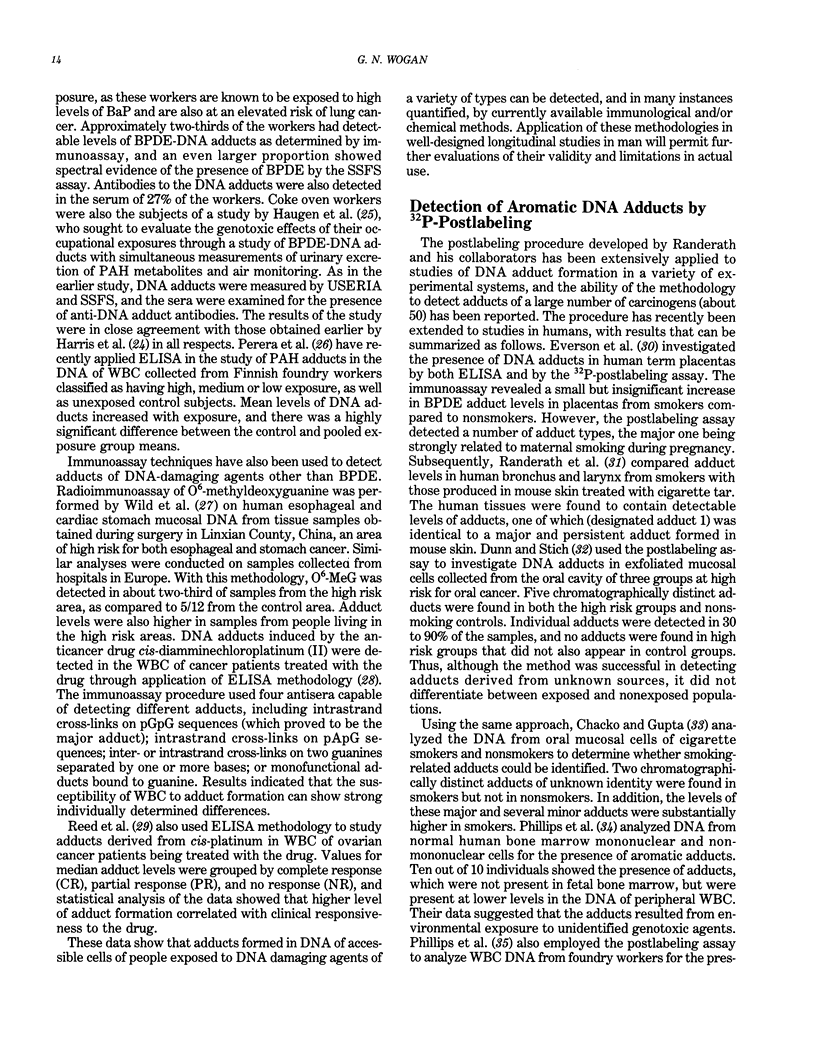
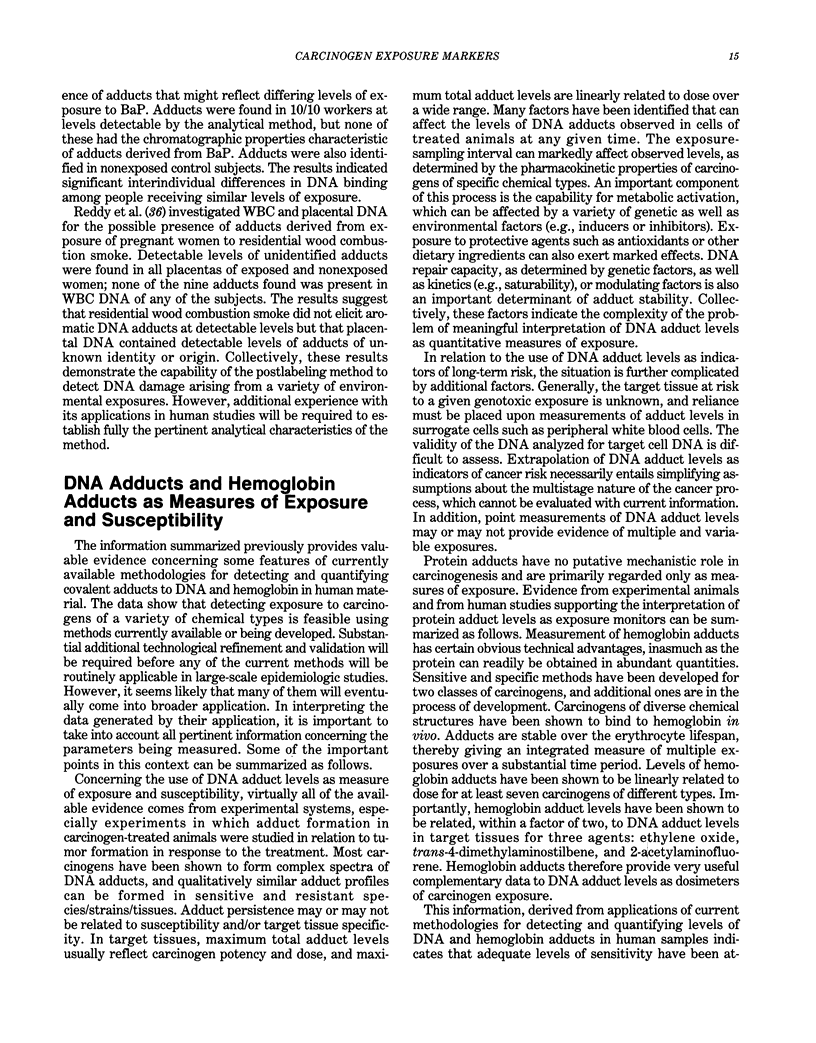
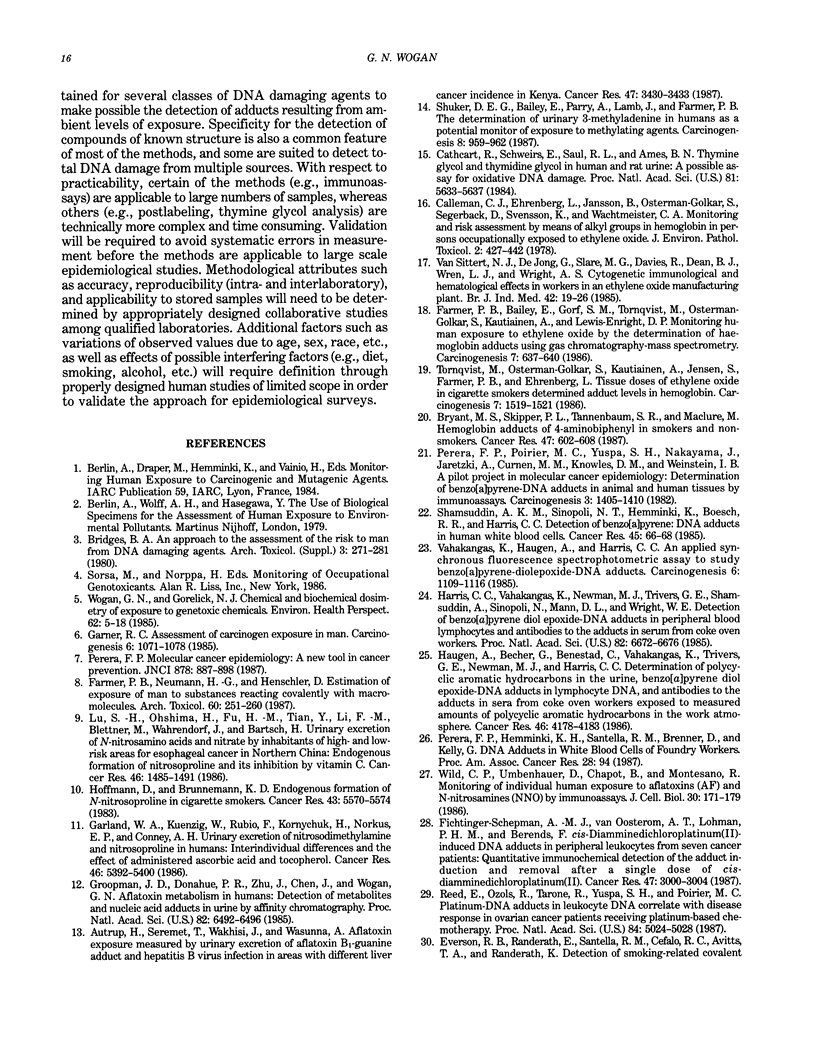

Selected References
These references are in PubMed. This may not be the complete list of references from this article.
- Autrup H., Seremet T., Wakhisi J., Wasunna A. Aflatoxin exposure measured by urinary excretion of aflatoxin B1-guanine adduct and hepatitis B virus infection in areas with different liver cancer incidence in Kenya. Cancer Res. 1987 Jul 1;47(13):3430–3433. [PubMed] [Google Scholar]
- Bridges B. A. An approach to the assessment of the risk to man from DNA damaging agents. Arch Toxicol Suppl. 1980;3:271–281. doi: 10.1007/978-3-642-67389-4_20. [DOI] [PubMed] [Google Scholar]
- Bryant M. S., Skipper P. L., Tannenbaum S. R., Maclure M. Hemoglobin adducts of 4-aminobiphenyl in smokers and nonsmokers. Cancer Res. 1987 Jan 15;47(2):602–608. [PubMed] [Google Scholar]
- Calleman C. J., Ehrenberg L., Jansson B., Osterman-Golkar S., Segerbäck D., Svensson K., Wachtmeister C. A. Monitoring and risk assessment by means of alkyl groups in hemoglobin in persons occupationally exposed to ethylene oxide. J Environ Pathol Toxicol. 1978 Nov-Dec;2(2):427–442. [PubMed] [Google Scholar]
- Cathcart R., Schwiers E., Saul R. L., Ames B. N. Thymine glycol and thymidine glycol in human and rat urine: a possible assay for oxidative DNA damage. Proc Natl Acad Sci U S A. 1984 Sep;81(18):5633–5637. doi: 10.1073/pnas.81.18.5633. [DOI] [PMC free article] [PubMed] [Google Scholar]
- Dunn B. P., Stich H. F. 32P-postlabelling analysis of aromatic DNA adducts in human oral mucosal cells. Carcinogenesis. 1986 Jul;7(7):1115–1120. doi: 10.1093/carcin/7.7.1115. [DOI] [PubMed] [Google Scholar]
- Everson R. B., Randerath E., Santella R. M., Cefalo R. C., Avitts T. A., Randerath K. Detection of smoking-related covalent DNA adducts in human placenta. Science. 1986 Jan 3;231(4733):54–57. doi: 10.1126/science.3941892. [DOI] [PubMed] [Google Scholar]
- Farmer P. B., Bailey E., Gorf S. M., Törnqvist M., Osterman-Golkar S., Kautiainen A., Lewis-Enright D. P. Monitoring human exposure to ethylene oxide by the determination of haemoglobin adducts using gas chromatography-mass spectrometry. Carcinogenesis. 1986 Apr;7(4):637–640. doi: 10.1093/carcin/7.4.637. [DOI] [PubMed] [Google Scholar]
- Farmer P. B., Neumann H. G., Henschler D. Estimation of exposure of man to substances reacting covalently with macromolecules. Arch Toxicol. 1987 Jun;60(4):251–260. doi: 10.1007/BF01234663. [DOI] [PubMed] [Google Scholar]
- Fichtinger-Schepman A. M., van Oosterom A. T., Lohman P. H., Berends F. cis-Diamminedichloroplatinum(II)-induced DNA adducts in peripheral leukocytes from seven cancer patients: quantitative immunochemical detection of the adduct induction and removal after a single dose of cis-diamminedichloroplatinum(II). Cancer Res. 1987 Jun 1;47(11):3000–3004. [PubMed] [Google Scholar]
- Garland W. A., Kuenzig W., Rubio F., Kornychuk H., Norkus E. P., Conney A. H. Urinary excretion of nitrosodimethylamine and nitrosoproline in humans: interindividual and intraindividual differences and the effect of administered ascorbic acid and alpha-tocopherol. Cancer Res. 1986 Oct;46(10):5392–5400. [PubMed] [Google Scholar]
- Garner R. C. Assessment of carcinogen exposure in man. Carcinogenesis. 1985 Aug;6(8):1071–1078. doi: 10.1093/carcin/6.8.1071. [DOI] [PubMed] [Google Scholar]
- Groopman J. D., Donahue P. R., Zhu J. Q., Chen J. S., Wogan G. N. Aflatoxin metabolism in humans: detection of metabolites and nucleic acid adducts in urine by affinity chromatography. Proc Natl Acad Sci U S A. 1985 Oct;82(19):6492–6496. doi: 10.1073/pnas.82.19.6492. [DOI] [PMC free article] [PubMed] [Google Scholar]
- Harris C. C., Vahakangas K., Newman M. J., Trivers G. E., Shamsuddin A., Sinopoli N., Mann D. L., Wright W. E. Detection of benzo[a]pyrene diol epoxide-DNA adducts in peripheral blood lymphocytes and antibodies to the adducts in serum from coke oven workers. Proc Natl Acad Sci U S A. 1985 Oct;82(19):6672–6676. doi: 10.1073/pnas.82.19.6672. [DOI] [PMC free article] [PubMed] [Google Scholar]
- Haugen A., Becher G., Benestad C., Vahakangas K., Trivers G. E., Newman M. J., Harris C. C. Determination of polycyclic aromatic hydrocarbons in the urine, benzo(a)pyrene diol epoxide-DNA adducts in lymphocyte DNA, and antibodies to the adducts in sera from coke oven workers exposed to measured amounts of polycyclic aromatic hydrocarbons in the work atmosphere. Cancer Res. 1986 Aug;46(8):4178–4183. [PubMed] [Google Scholar]
- Hoffmann D., Brunnemann K. D. Endogenous formation of N-nitrosoproline in cigarette smokers. Cancer Res. 1983 Nov;43(11):5570–5574. [PubMed] [Google Scholar]
- Lu S. H., Ohshima H., Fu H. M., Tian Y., Li F. M., Blettner M., Wahrendorf J., Bartsch H. Urinary excretion of N-nitrosamino acids and nitrate by inhabitants of high- and low-risk areas for esophageal cancer in Northern China: endogenous formation of nitrosoproline and its inhibition by vitamin C. Cancer Res. 1986 Mar;46(3):1485–1491. [PubMed] [Google Scholar]
- Perera F. P. Molecular cancer epidemiology: a new tool in cancer prevention. J Natl Cancer Inst. 1987 May;78(5):887–898. [PubMed] [Google Scholar]
- Perera F. P., Poirier M. C., Yuspa S. H., Nakayama J., Jaretzki A., Curnen M. M., Knowles D. M., Weinstein I. B. A pilot project in molecular cancer epidemiology: determination of benzo[a]pyrene--DNA adducts in animal and human tissues by immunoassays. Carcinogenesis. 1982;3(12):1405–1410. doi: 10.1093/carcin/3.12.1405. [DOI] [PubMed] [Google Scholar]
- Phillips D. H., Hewer A., Grover P. L. Aromatic DNA adducts in human bone marrow and peripheral blood leukocytes. Carcinogenesis. 1986 Dec;7(12):2071–2075. doi: 10.1093/carcin/7.12.2071. [DOI] [PubMed] [Google Scholar]
- Randerath E., Avitts T. A., Reddy M. V., Miller R. H., Everson R. B., Randerath K. Comparative 32P-analysis of cigarette smoke-induced DNA damage in human tissues and mouse skin. Cancer Res. 1986 Nov;46(11):5869–5877. [PubMed] [Google Scholar]
- Reed E., Ozols R. F., Tarone R., Yuspa S. H., Poirier M. C. Platinum-DNA adducts in leukocyte DNA correlate with disease response in ovarian cancer patients receiving platinum-based chemotherapy. Proc Natl Acad Sci U S A. 1987 Jul;84(14):5024–5028. doi: 10.1073/pnas.84.14.5024. [DOI] [PMC free article] [PubMed] [Google Scholar]
- Shamsuddin A. K., Sinopoli N. T., Hemminki K., Boesch R. R., Harris C. C. Detection of benzo(a)pyrene:DNA adducts in human white blood cells. Cancer Res. 1985 Jan;45(1):66–68. [PubMed] [Google Scholar]
- Shuker D. E., Bailey E., Parry A., Lamb J., Farmer P. B. The determination of urinary 3-methyladenine in humans as a potential monitor of exposure to methylating agents. Carcinogenesis. 1987 Jul;8(7):959–962. doi: 10.1093/carcin/8.7.959. [DOI] [PubMed] [Google Scholar]
- Törnqvist M., Osterman-Golkar S., Kautiainen A., Jensen S., Farmer P. B., Ehrenberg L. Tissue doses of ethylene oxide in cigarette smokers determined from adduct levels in hemoglobin. Carcinogenesis. 1986 Sep;7(9):1519–1521. doi: 10.1093/carcin/7.9.1519. [DOI] [PubMed] [Google Scholar]
- Vahakangas K., Haugen A., Harris C. C. An applied synchronous fluorescence spectrophotometric assay to study benzo[a]pyrene-diolepoxide-DNA adducts. Carcinogenesis. 1985 Aug;6(8):1109–1115. doi: 10.1093/carcin/6.8.1109. [DOI] [PubMed] [Google Scholar]
- Van Sittert N. J., de Jong G., Clare M. G., Davies R., Dean B. J., Wren L. J., Wright A. S. Cytogenetic, immunological, and haematological effects in workers in an ethylene oxide manufacturing plant. Br J Ind Med. 1985 Jan;42(1):19–26. doi: 10.1136/oem.42.1.19. [DOI] [PMC free article] [PubMed] [Google Scholar]
- Wild C. P., Umbenhauer D., Chapot B., Montesano R. Monitoring of individual human exposure to aflatoxins (AF) and N-nitrosamines (NNO) by immunoassays. J Cell Biochem. 1986;30(2):171–179. doi: 10.1002/jcb.240300206. [DOI] [PubMed] [Google Scholar]
- Wogan G. N., Gorelick N. J. Chemical and biochemical dosimetry of exposure to genotoxic chemicals. Environ Health Perspect. 1985 Oct;62:5–18. doi: 10.1289/ehp.85625. [DOI] [PMC free article] [PubMed] [Google Scholar]


